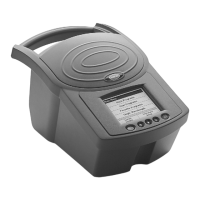DR/2400
Fluoride
Fluoride_AccuVac_Other_SPD_Eng_Ody.fm Page 1 of 6
• The sample and deionized water should be at the same temperature (±1 °C). Temperature adjustments may be made before or
after reagent addition.
• SPADNS Reagent is toxic and corrosive. Use care while handling the reagent.
• For best results, measure the volume of SPADNS Reagent as accurately as possible.
• Wipe the outside of sample cells before each insertion into the instrument cell holder. Use a damp towel followed by a dry one to
remove fingerprints or other marks.
• SPADNS Reagent contains sodium arsenite. Final solutions will contain arsenic (D004) in sufficient concentration to be regulated
as a hazardous waste for Federal RCRA. See Section 4 for information on proper disposal of these materials.
• If the instrument displays OVER!, dilute a fresh sample (5 mL) with an equal volume of deionized water and repeat the test, using
this solution in step 2. Multiply the result by 2.
Fluoride
(Method 8029
SPADNS Method*
*Adapted from Standard Methods for the Examination of Water and Wastewater, 4500-F B & D
Reagent Solution or AccuVac
®
Ampuls
(0.02 to 2.00 mg/L F
–
)
Scope and Application: For water, wastewater and seawater; USEPA accepted for reporting for
drinking and wastewater analyses (distillation required; see Distillation on page 3)**
** Procedure is equivalent to USEPA method 340.1 for drinking water and wastewater.
1. Touch
Hach Programs.
Select program
190 Fluoride.
Touch
Start.
2. Pipet 10.0 mL of
sample into a dry, round
sample cell (this is the
prepared sample).
3. Pipet 10.0 mL of
deionized water into a
second dry, round sample
cell (this is the blank).
4. Carefully pipet
2.0 mL of SPADNS
Reagent into each cell.
Swirl to mix.
Tips and Techniques
10 mL
20 mL
25 mL
Using SPADNS Reagent Method 8029
Hach Programs
10 mL 10 mL
10 mL 10 mL

